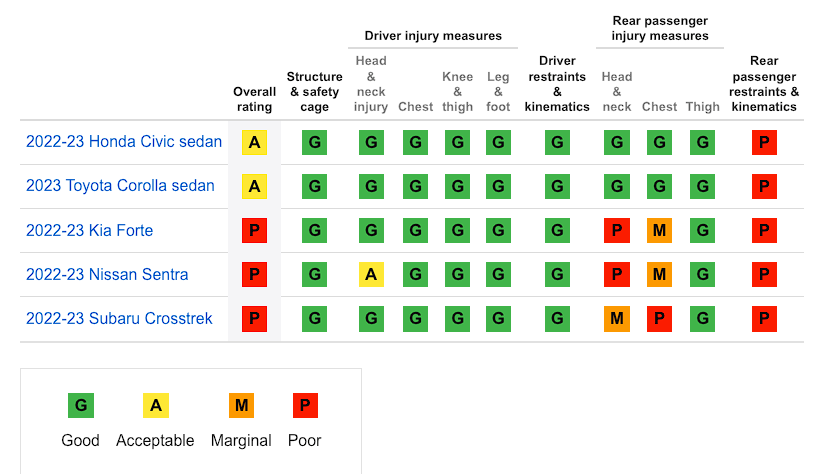Safety Gap Exposed: Small Cars Fail Rear Occupant Protection (PDF)
In a recent study conducted by the Insurance Institute for Highway Safety (IIHS), alarming results have emerged concerning the safety of rear-seat passengers in small cars. The crash tests performed on popular models like the Toyota Corolla, Honda Civic, Kia Forte, Subaru Crosstrek, and Nissan Sentra revealed significant deficiencies in protecting rear occupants.
Small Cars Fail Crash Test Ratings
The IIHS employed its moderate-overlap crash test to evaluate the crashworthiness of these small vehicles. Surprisingly, none of the tested cars achieved the top Good rating for overall crash protection. While the Honda Civic and Toyota Corolla managed to secure an Acceptable rating, the remaining three models – Kia Forte, Nissan Sentra, and Subaru Crosstrek – received a disappointing Poor rating from the IIHS.

Rear-Seat Occupants at Risk
The lackluster ratings are largely attributed to the absence of modern safety measures for rear-seat passengers. Throughout the tests, the rear dummies experienced a concerning phenomenon known as “submarining.” This occurs when the lap portion of the seatbelt slides up into the abdominal region upon impact, significantly increasing the risk of severe internal injuries and potentially fatal outcomes in the event of a crash.
Exploring the Root Cause
These findings do not imply a regression in rear-seat occupant safety equipment; rather, they shed light on the advancements made in protecting front-seat occupants. The increasing focus on innovative seatbelt and airbag designs for those in the front has inadvertently created a gap in rear-seat occupant protection. Consequently, the IIHS emphasizes the urgent need to extend these advancements to rear seats, advocating for comprehensive safety measures that safeguard all vehicle occupants.
The Importance of Rear Seat Safety
While the results are concerning, it’s important to note that the rear seats still remain the safest place for young children. This is due to the potential risks posed by inflating front airbags, making it preferable for young children to occupy the rear seats for their safety.
The recent crash tests conducted by the IIHS have unveiled critical gaps in protecting rear-seat occupants in small cars. As manufacturers prioritize the safety of front-seat occupants, it becomes imperative to address the disparities in safeguarding those in the rear. The findings serve as a strong call to action for the automotive industry to develop and implement advanced safety measures that prioritize the well-being of all occupants. By closing the safety gap, we can ensure that every journey is a safer one for everyone on the road.




